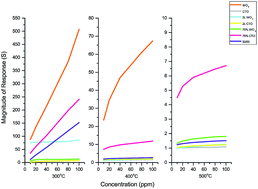An array of WO3 and CTO heterojunction semiconducting metal oxide gas sensors used as a tool for explosive detection
Abstract
Terrorists frequently use explosives and they represent an imminent threat to national and global security. Recent events highlight the necessity of explosive detection, demonstrating the need for developing and applying new sensors for explosive gas detection. Semiconducting metal oxide gas sensors can be incorporated into electronic noses, which provide a cheap, portable and highly sensitive device. Using unmodified, admixed and 2-layered sensors consisting of WO3 and chromium titanium oxide (CTO), an array of seven heterojunction semiconducting metal oxide sensors was produced. All seven sensors were tested against four gases associated with explosive materials. The sensitivity was improved by using 2-layered sensors in response to ethanol, ammonia and nitromethane, whereas the admixed sensors showed high sensitivity when exposed to nitrogen dioxide. The selectivity of the array of sensors was tested using machine-learning techniques with a support vector machine. The technique produced good data classification when classifying the gases used within the study.



 Please wait while we load your content...
Please wait while we load your content...